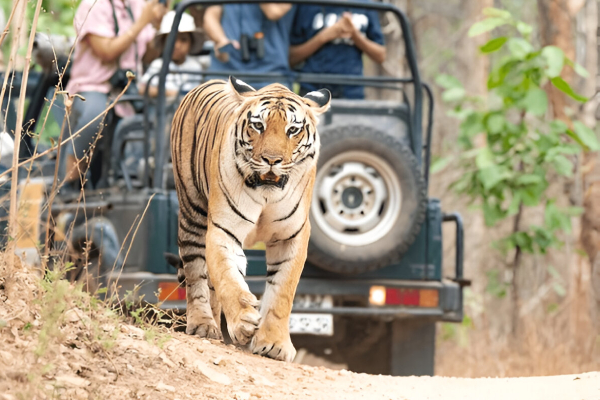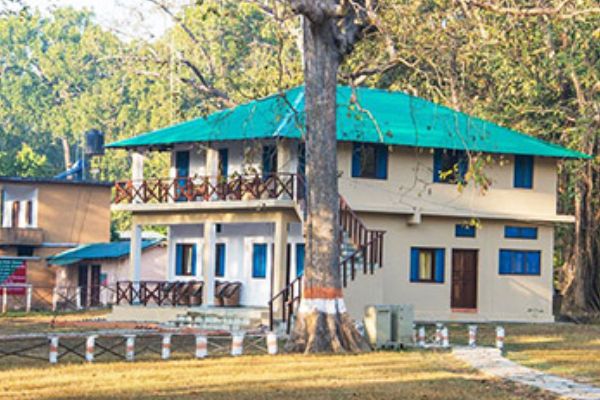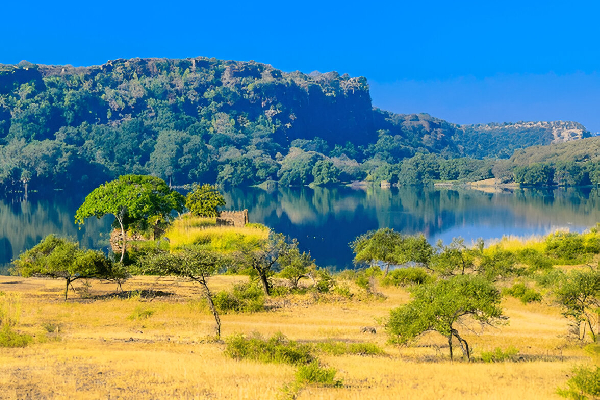About Jim Corbett National Park
Jim Corbett National Park is renowned for its rich natural heritage, featuring varied topography, diverse flora and fauna, the beauty of the meandering Ramganga River, and stunning landscapes. The elusive Tiger, a focal point for every tourist, along with wild Elephants and Leopards, are the main attractions, complemented by numerous other mammal and bird species. It is one of the few national parks in India that offers basic lodging facilities in the heart of the jungle at Dhikala, providing an awe-inspiring setting and picturesque location.
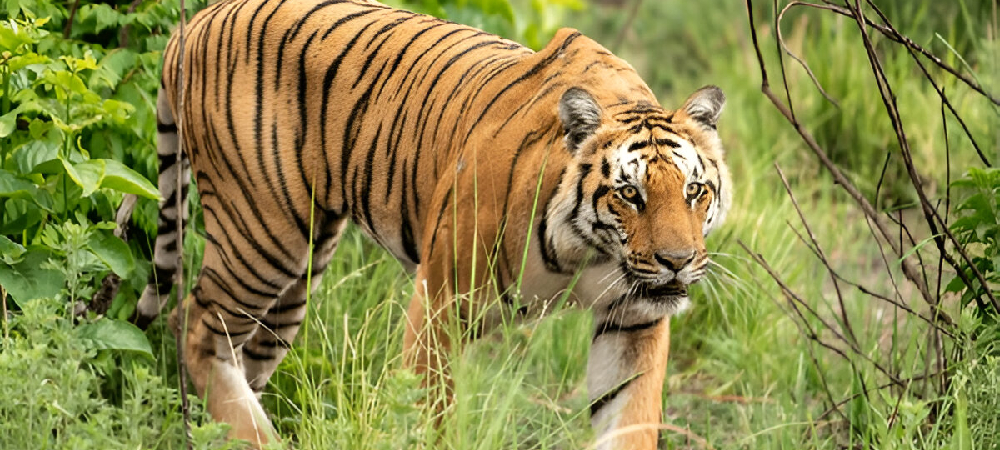
Corbett National Park (CNP) is one of India's richest wilderness areas, encompassing a total area of 1288.34 sq km, which includes two Protected Areas: Corbett National Park (520.82 sq. km) and Sonanadi Wildlife Sanctuary (301.18 sq. km).
The park has captivated many with its diverse wildlife and breathtaking landscapes. Its natural uniqueness was recognized long ago, leading to its establishment in 1936 as the first national park in mainland Asia.
Corbett National Park spans two districts—Nainital and Pauri—in the hill state of Uttarakhand, covering an area of 521 sq. km. Together with the adjacent Sonanadi Wildlife Sanctuary and Reserve Forest areas, it forms the Corbett Tiger Reserve, which extends over 1288 sq. km.
Its geographical location between the Himalayas and the terai, along with the streams, rivers, and ridges crisscrossing the terrain, provides Corbett with a remarkable variety of landscapes. This vivid mosaic of habitats—wet and dry, plain and mountainous, gentle and rugged, forests and grasslands—supports numerous plant and animal species, representing both Himalayan and plains ecosystems. The most famous residents of Corbett are the Bengal Tiger and the Asiatic Elephant, while the park is also home to about 600 species of birds, making it one of the richest bird regions in India.
Jim Corbett National Park is one of the most celebrated wildlife reserves in India, spanning the districts of Nainital, Pauri, and Almora. The park is a stunning blend of high hills, swamps, riverside belts, and green meadows, covering an area of 522 kilometers at the foothills of the great Himalayas, making it a paradise for wildlife adventure enthusiasts.
The park is famous for its variety of rare flora, wild animals, reptiles, and bird species. A pathway lined with mango orchards leads visitors into a world that houses a record number of 488 different plant species and 580 bird types. Additionally, the park is home to 25 reptile species and 50 mammal species, making it a wonderland worth exploring. Visitors are allowed to enter Corbett National Park from May to June.
Initially named 'Hailey National Park,' it was later renamed 'Corbett National Park' in honor of James Edward Corbett, a noted hunter turned conservationist. The area became part of 'Project Tiger' in 1971 when the Government of India launched this ambitious conservation initiative.
Jim Corbett National Park, part of the larger Corbett Tiger Reserve, is located in the Nainital district of Uttarakhand. The park is renowned for its rich tiger population and was established in 1936 as Hailey National Park, making it India's oldest and most prestigious national park. It is also recognized as the birthplace of Project Tiger, launched in 1973 to protect the endangered Royal Bengal Tiger.
Spanning over 520 square kilometers, the park comprises hills, marshy depressions, riverine belts, grasslands, and large lakes. It is one of the few tiger reserves in India that allows overnight stays within the national park. Nature watching and wildlife viewing can be done in open four-wheeler Jeeps or on elephant back. The park shelters a healthy population of tigers and rare species like Otters and the endemic fish-eating crocodile, making it a sought-after destination for wildlife enthusiasts. Dhikala, located at the border of the expansive Patil Dun valley, is the most popular destination in Corbett due to its superb location and abundant wildlife.
Today, after the addition of areas to the originally declared national park, the total area of the Tiger Reserve extends to 1288.31 sq. km, covering three districts of Uttarakhand: Pauri, Nainital, and Almora. Corbett National Park itself covers 521 sq. km and, along with the neighboring Sonanadi Wildlife Sanctuary and Reserve Forest areas, forms the Corbett Tiger Reserve. Geographically, it lies between the Shiwalik Himalayas and the terai, with streams, rivers, and ridges creating a remarkable variety of landscapes. This diverse mosaic of habitats supports numerous plant and animal species, representing both Himalayan and plains ecosystems. The most famous wild residents are the Royal Bengal Tiger and the Asiatic Elephant. Additionally, with over 550 species of birds, Corbett is one of the richest bird regions in the country and has been designated an 'Important Bird Area' (IBA) by BirdLife International.
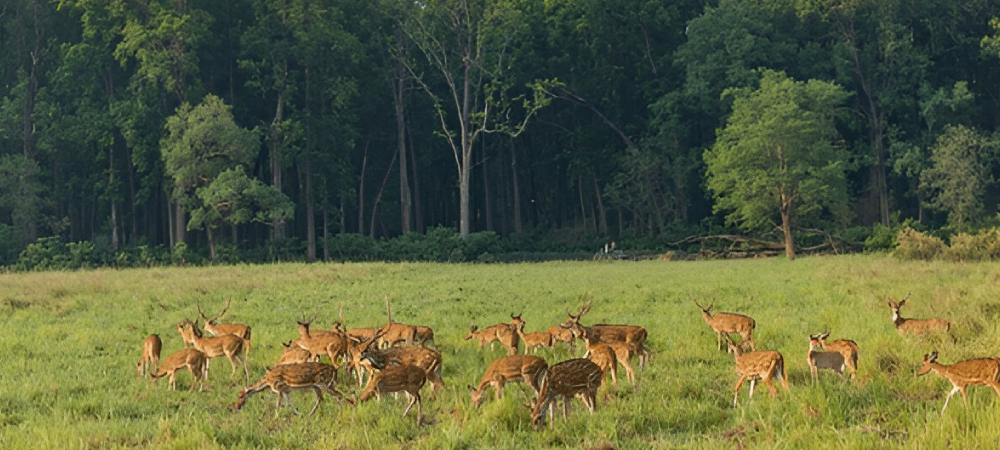
For bird watchers, Corbett is a true paradise. The park and its surrounding areas are home to more than 650 species of resident and migratory birds. Dhikala, in particular, is an excellent spot for observing birds of prey, with over 50 species of raptors showcasing the area's healthy biodiversity. Their fascinating behaviors and varied songs are a delight to experience. In summary, this premier national park in India is renowned for its rich and diverse wildlife, including the Royal Bengal Tiger, elephants, several species of deer, and a vibrant bird population.
The Tourist Zones:
To promote tourism in the region, Corbett National Park has been divided into five distinct zones. These marked buffer or core areas of the park allow visitors to partake in wildlife safaris and observe the intriguing behaviors of animals up close.
Bijrani Safari Zone:
Bijrani Zone is a popular tourist destination due to its abundant natural beauty and open grasslands. The entry gate is located just 1 km from Ramnagar city.
Jhirna Safari Zone:
Jhirna is another significant tourist zone in Jim Corbett National Park that remains open to visitors year-round. Jhirna Gate is situated 16 km from Ramnagar city.
Dhela Safari Zone:
Dhela is a new eco-tourism zone in Corbett National Park, included in the tiger reserve zone in November 2014. This is the only area in the reserve's buffer zone open to tourists in CTR. The zone attracts many visitors due to its rich flora and fauna and is open throughout the year, located approximately 13 km from Ramnagar City.
Dhikala Zone:
As the largest and most diverse zone in Corbett, Dhikala is renowned for its stunning natural beauty and offers the best opportunities for viewing exotic fauna. The entry gate is 18 km from Ramnagar city. Night stays within the Dhikala Tourism Zone are highly recommended for dedicated wildlife enthusiasts.
Durga Devi Zone:
Located on the northeastern boundary of Jim Corbett National Park, Durga Devi Zone is a paradise for bird watchers. The entry gate is approximately 36 km from Ramnagar city.
Corbett Landscape (Sitabani) Zone:
The Corbett Landscape (Sitabani) Zone does not fall under the Corbett Tiger Reserve area. If you appreciate the serene ambiance of natural beauty, a visit to the Sitabani area is a must.
How to Reach Corbett
Ramnagar is the best access point to Corbett National Park, serving as the headquarters of CTR. This small city is well connected by road and rail to major cities in India, including Delhi, Moradabad, Nainital, and Bareilly. Once you arrive in Ramnagar, it takes only half an hour to reach Corbett National Park, which is about 15 km from the Ramnagar railway station.
By Road:
Ramnagar has an excellent road network connecting various cities. Corbett National Park is approximately 260 kilometers from India's national capital, Delhi. The Uttarakhand state government operates buses at short intervals from Delhi, Moradabad, Haldwani, and Nainital that reach Corbett directly.
By Rail:
The railway station in Ramnagar receives trains from major cities in India, including Delhi, Moradabad, and Bareilly. A direct train from Delhi to Ramnagar is available. Notable trains include the Ranikhet Express, Corbett Link Express, and Kathgodam Express, which take you directly to Ramnagar.
Distance from Major Cities:
- Delhi: Delhi - Moradabad - Kashipur - Ramnagar (260 Kms)
- Nainital: Via Kaladhungi to Ramnagar (62 Kms)
- Lucknow: Lucknow - Bareilly - Kicha - Rudrapur - Kashipur - Ramnagar (436 km)
- Dehradun: Dehradun - Ramnagar (232 km)
Inside Corbett Tiger Reserve zone-wise Night Stay Accommodation facilities are available as follows:
Accommodation facilities are available in Dhikala, Sarpdhuli, Gairal, Sultan, Bijrani, Malani, Jhirna, Dhela, Halduparao, Kanda, and Lohachaur in the Sonanadi Tourism Zone. All rooms are equipped with double beds and basic amenities. A twelve-bed dormitory at Dhikala and an eight-bed dormitory at Gairal are also available for visitors wishing to stay inside the forest.
Night Stay Accommodation Booking
Inside Corbett Tiger Reserve zone-wise Jeep Safari facilities are available as follows:
In addition to Night Stay Accommodation facilities in the forest rest houses, Corbett Tiger Reserve also offers Day Visit/Jungle Safari facilities for visiting tourists. This is a preferred option for many tourists who cannot stay for extended periods or wish to stay outside the park. Day Visit/Jungle Safari is conducted 'only' with vehicles registered with the park administration, as private vehicles are not permitted inside the park. Bookings for Day Visit/Jungle Safari can be made through this website.
Jeep Safari Day Visit Booking
Another way to explore the picturesque park is through the 'Ramganga conducted tour,' which takes tourists to the Dhikala Zone for Day Visits in Canters (with a capacity of up to 16 adults). Each day, two Canter rides are conducted in the morning and two in the evening.
Each tourist season, the Dhikala Ecotourism zone opens for day visits (via Ramganga Conducted Tours) after the monsoon on the 15th of November, while Durga Devi and Bijrani Zones open for day visits from the 15th of October. Jhirna and Dhela remain open year-round for day visits. The Bijrani ecotourism zone is particularly popular among tourists for its beautiful Sal forest and expansive grasslands. Elephant safaris are also conducted here for interested visitors. The safaris provide a great opportunity for learning about Indian wildlife and conservation efforts.
Along with Bijrani, to enhance visitor convenience and streamline tourism management in Corbett Tiger Reserve, the reserve has been divided into six distinct tourism zones, each with a separate entry gate.
| Zone | Entry Gate |
|---|---|
| Dhikala | Dhangarhi |
| Bijrani | Amdanda |
| Jhirna | Dhela |
| Sonanadi | Vatanvasa |
| Durgadevi | Durgadevi |
| Dhela | Dhela |
Terms and Conditions:
- Day visits to all zones are strictly regulated based on scientifically calculated carrying capacity, with a limited number of vehicles permitted entry during each morning and afternoon.
- Permits for day visits to the Sonanadi Ecotourism zone can be obtained from the visitor reception center located at Kotdwar.
- Permits for day visits to other zones are available online on our website.
- Visitors are advised to familiarize themselves with gate timings and arrive well before the designated time to avoid any inconvenience.
- Private vehicles are 'not' allowed entry for tourism purposes into the park; visitors must use specially designed vehicles registered with CTR for this purpose. Day visits to the Dhikala Ecotourism Zone are permitted only through specially designed Canter buses via Ramganga Conducted Tours.
- Visitors can also enjoy elephant rides at Bijrani and Dhikala ecotourism zones, available on a 'first come, first served' basis.
- Canteen facilities are available at Dhikala, Bijrani, and Gairal. At other locations, kitchen facilities have been provided.




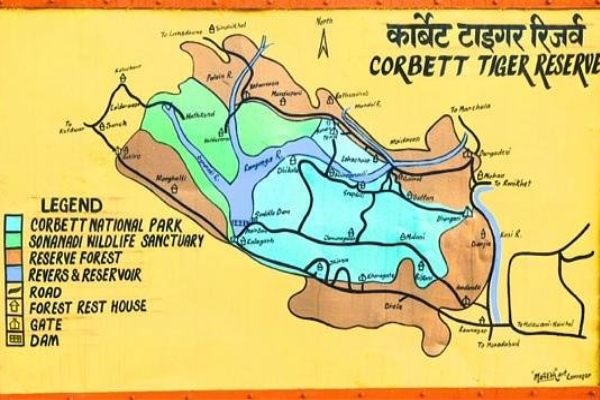
.jpg)
